Physical Address
304 North Cardinal St.
Dorchester Center, MA 02124
Physical Address
304 North Cardinal St.
Dorchester Center, MA 02124

Global Earth Observation Decentralized Network (GEODNET) is a Decentralized Physical Infrastructure Network (DePIN) project that delivers high-precision geospatial data and positioning through a decentralized Real-Time Kinematics (RTK) network. The network operates on a community-driven model where individual operators install RTK Base Stations, also known as Satellite Miners, on their property. Satellite Miners receive Global Navigation Satellite System (GNSS) signals and provide real-time correction data with 1 cm accuracy, which is then transmitted to GEODNET’s cloud platform.
GEOD is the utility token of the GEODNET network and is primarily deployed on Polygon, with multichain support recently extended to Solana via Wormhole. GEOD is used to reward satellite miner users, pay for RTK data, and enable participation in governance.
Since its launch in December 2021, GEODNET has expanded to over 19,000 RTK Base Stations globally, accounting for over $4 million in annualized revenue.
Since 2023, GEODNET has raised a total of $15 million to support its development, with the latest round being an $8 million strategic investment led by Multicoin Capital in February 2025.
For a full primer on GEODNET, refer to our Initiation of Coverage report.
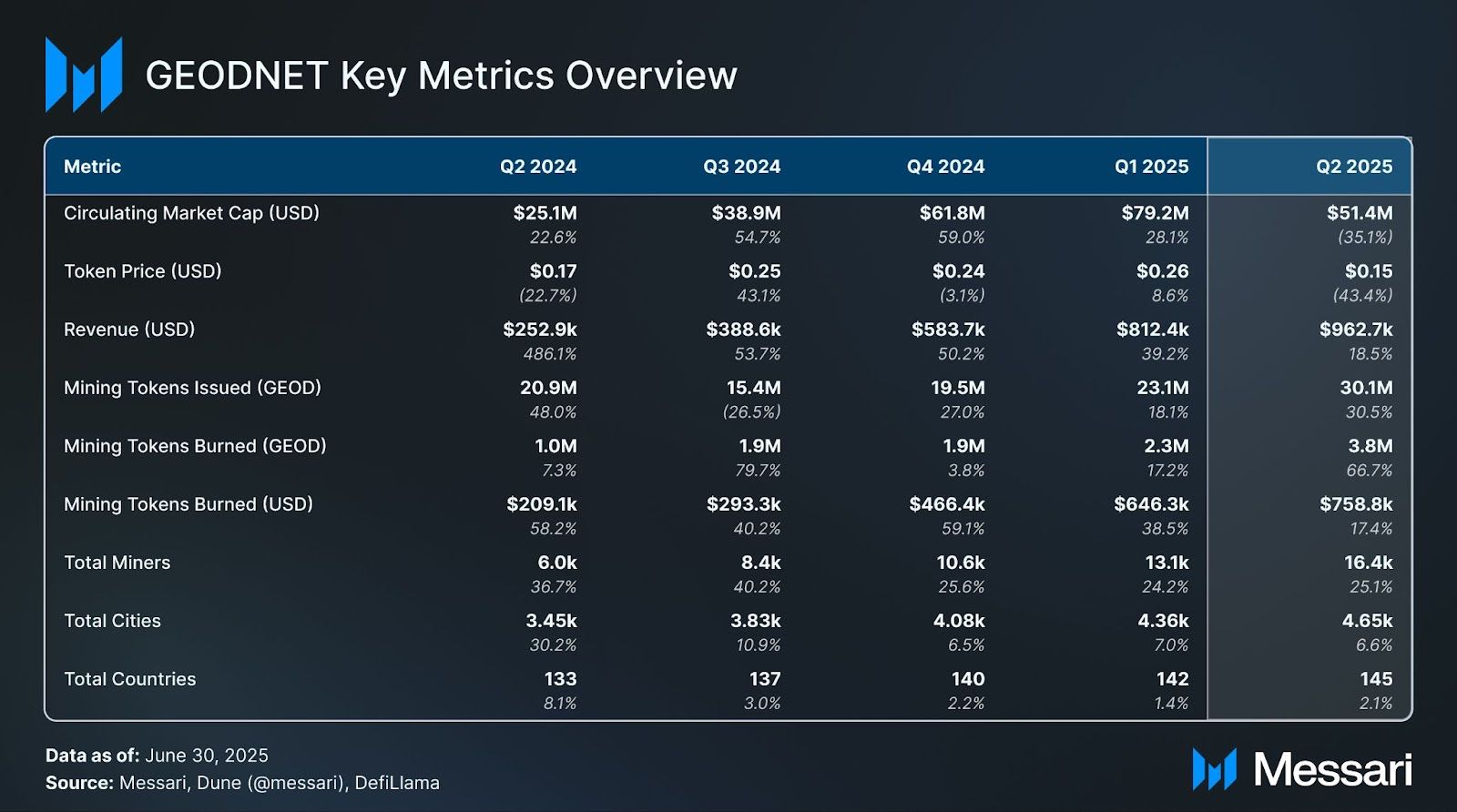
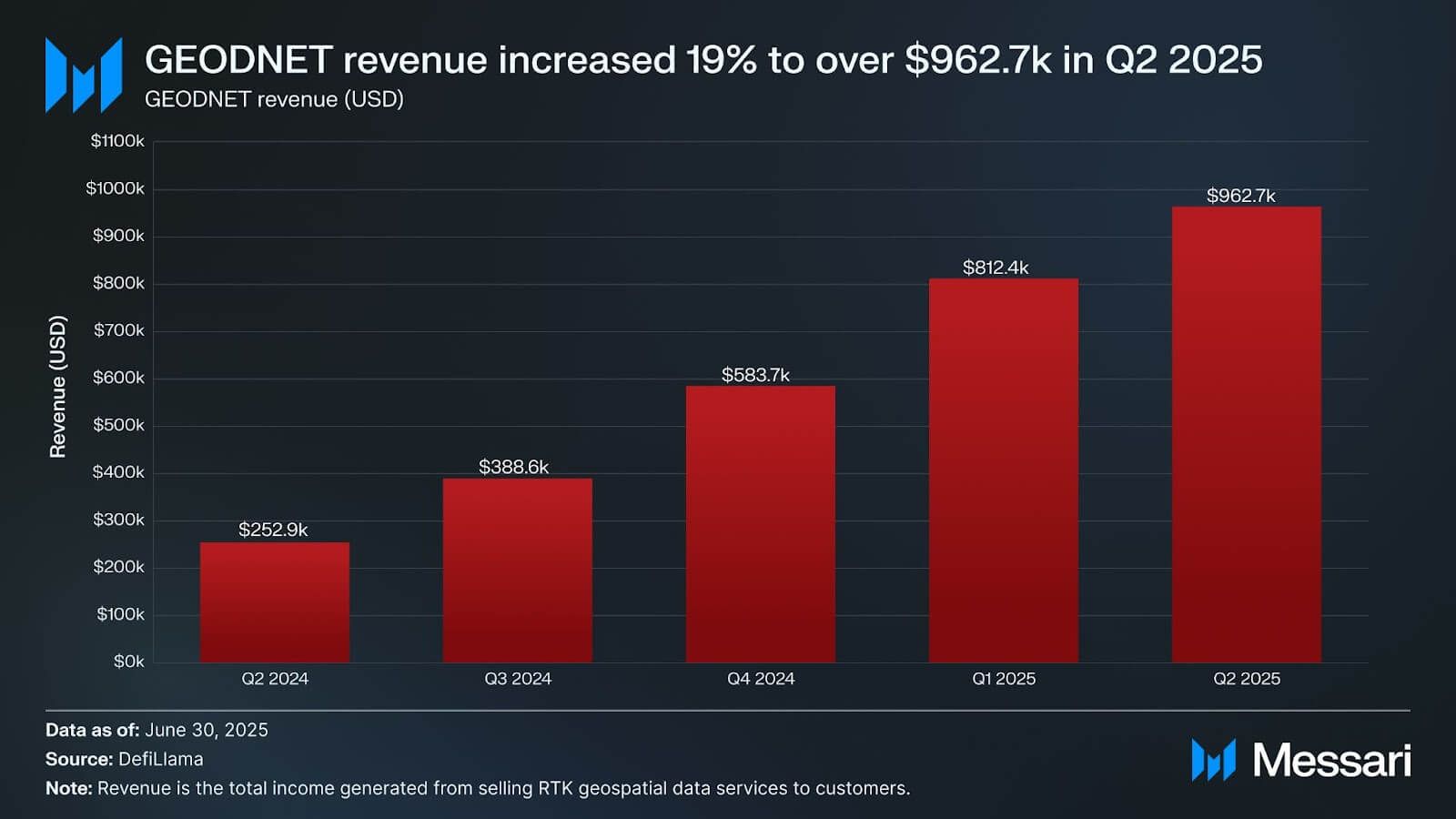
GEODNET generates revenue by selling high-precision RTK geospatial data services to customers. In Q2 2025, revenue grew 19% QoQ, rising from $812,000 to over $963,000, supported by the global expansion of its RTK station network. This brings GEODNET’s annualized revenue to approximately $3 million, placing it well above the sector median. According to Messari’s State of DePIN report, only 25 of 80 analyzed DePIN projects generate revenue, with median revenue for Physical Resource Networks (PRNs) at $730,000. GEODNET’s performance highlights its status as one of the top-earning DePIN protocols, particularly among hardware-driven networks.
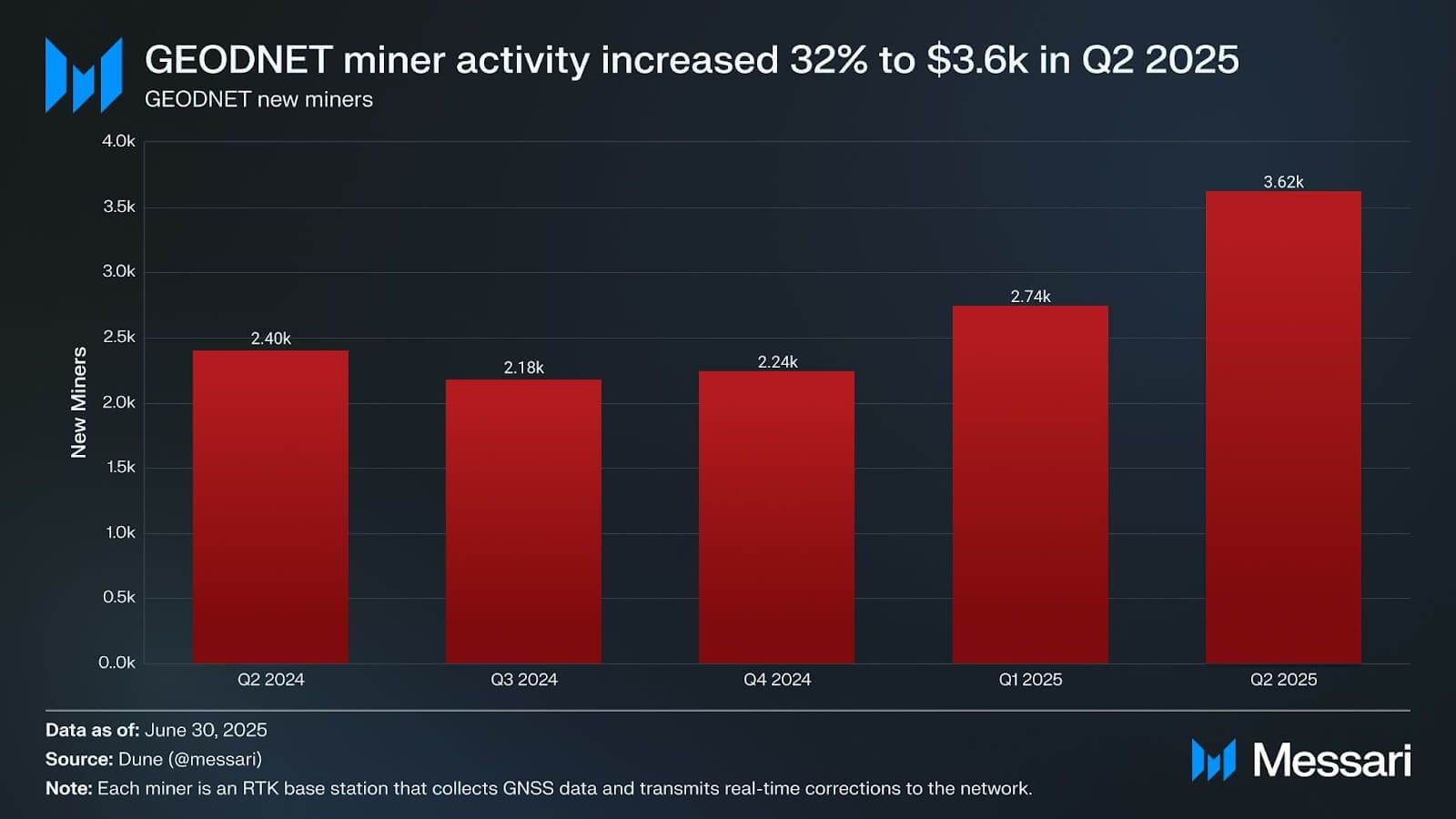
GEODNET operates on a decentralized model where individuals set up RTK Base Stations, called Satellite Miners, on their property. These stations capture satellite signals and produce real-time correction data with centimeter-level accuracy, which is sent to GEODNET’s cloud platform. In return, station operators earn daily GEOD token rewards. In Q2 2025, the network added over 3,600 new active miners, representing a 32% increase from 2,700 in Q1.
The network also surpassed 19,000 active Satellite Miners worldwide, marking a 35% increase from over 14,000 in the previous quarter.
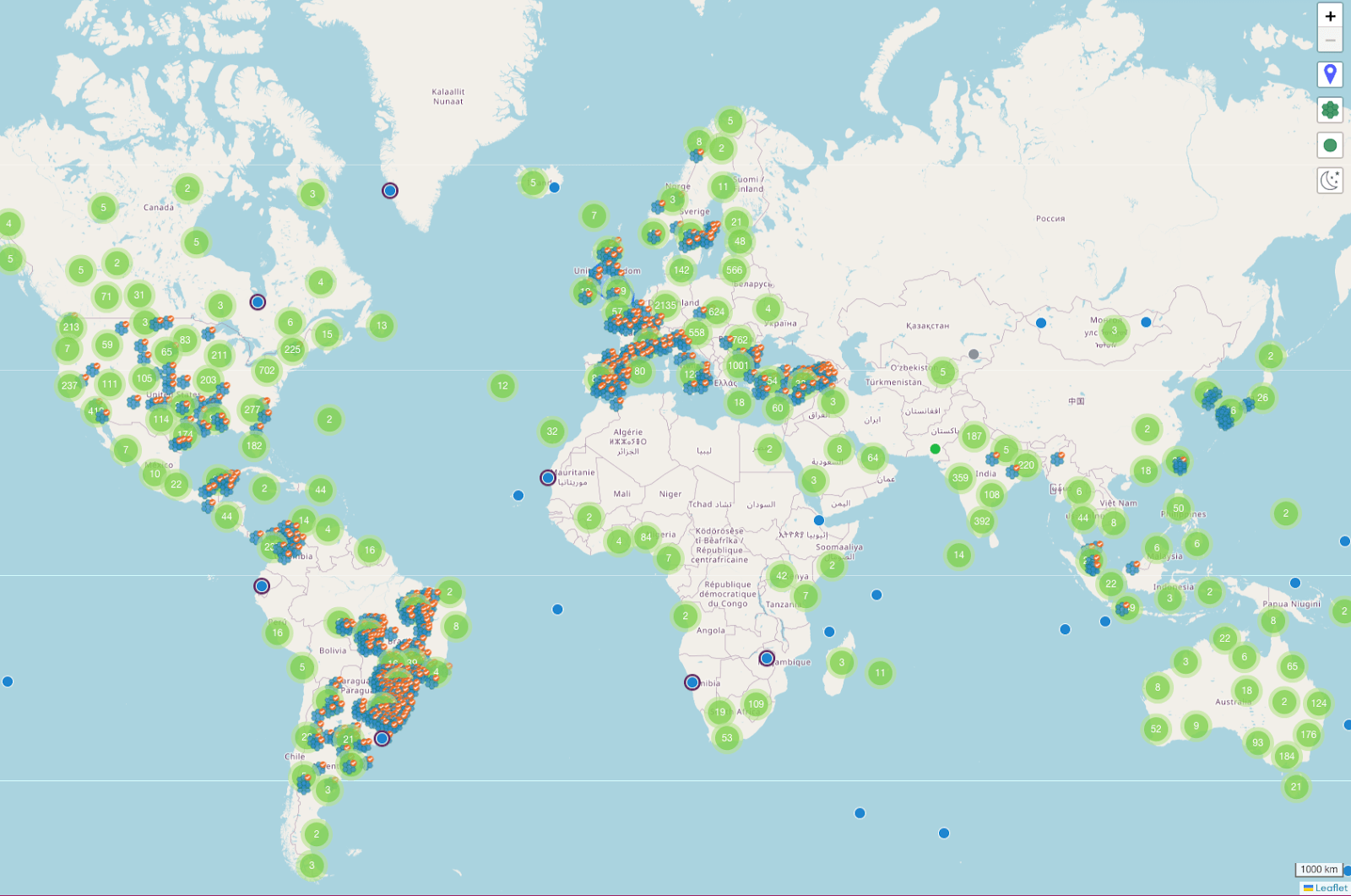
GEODNET’s infrastructure spans more than 145 countries and over 4,600 cities. The highest concentration of miners is in the United States and Europe, with a significant presence in South America, Australia, and India. The network also has a growing presence in Japan, South Korea, and South Africa.
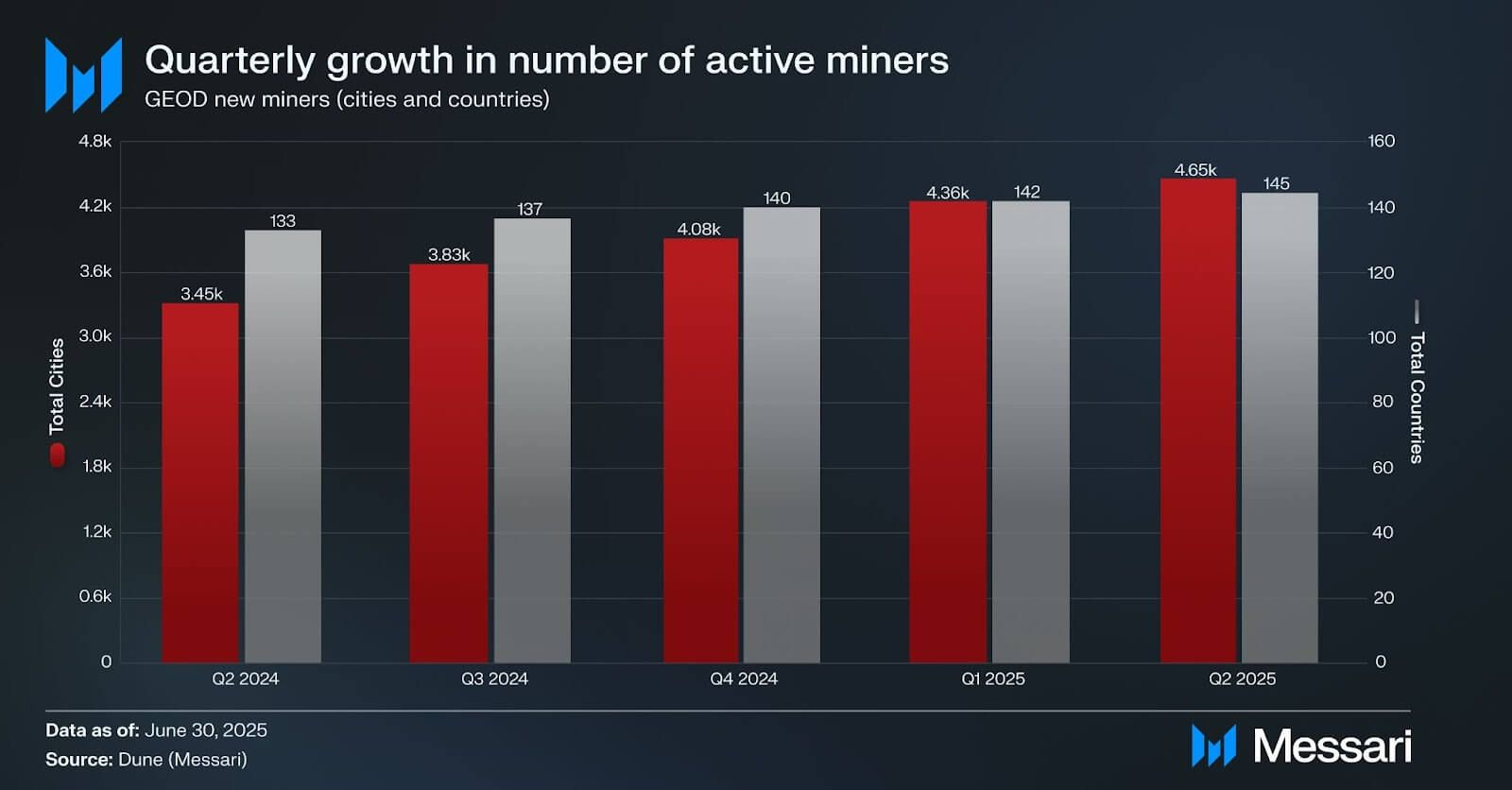
The number of cities with active Satellite Miners grew from 4,360 to 4,650, representing a 7% QoQ increase. Country-level distribution also grew, expanding from 142 to 145. The increase was likely driven by the rollout of GIP-6, which shifted mining rewards to a performance-based model to encourage higher-quality station deployments. By tying rewards to performance metrics instead of boosting token emissions, the mechanism improves data reliability while supporting sustainable network growth and maintaining token supply discipline.
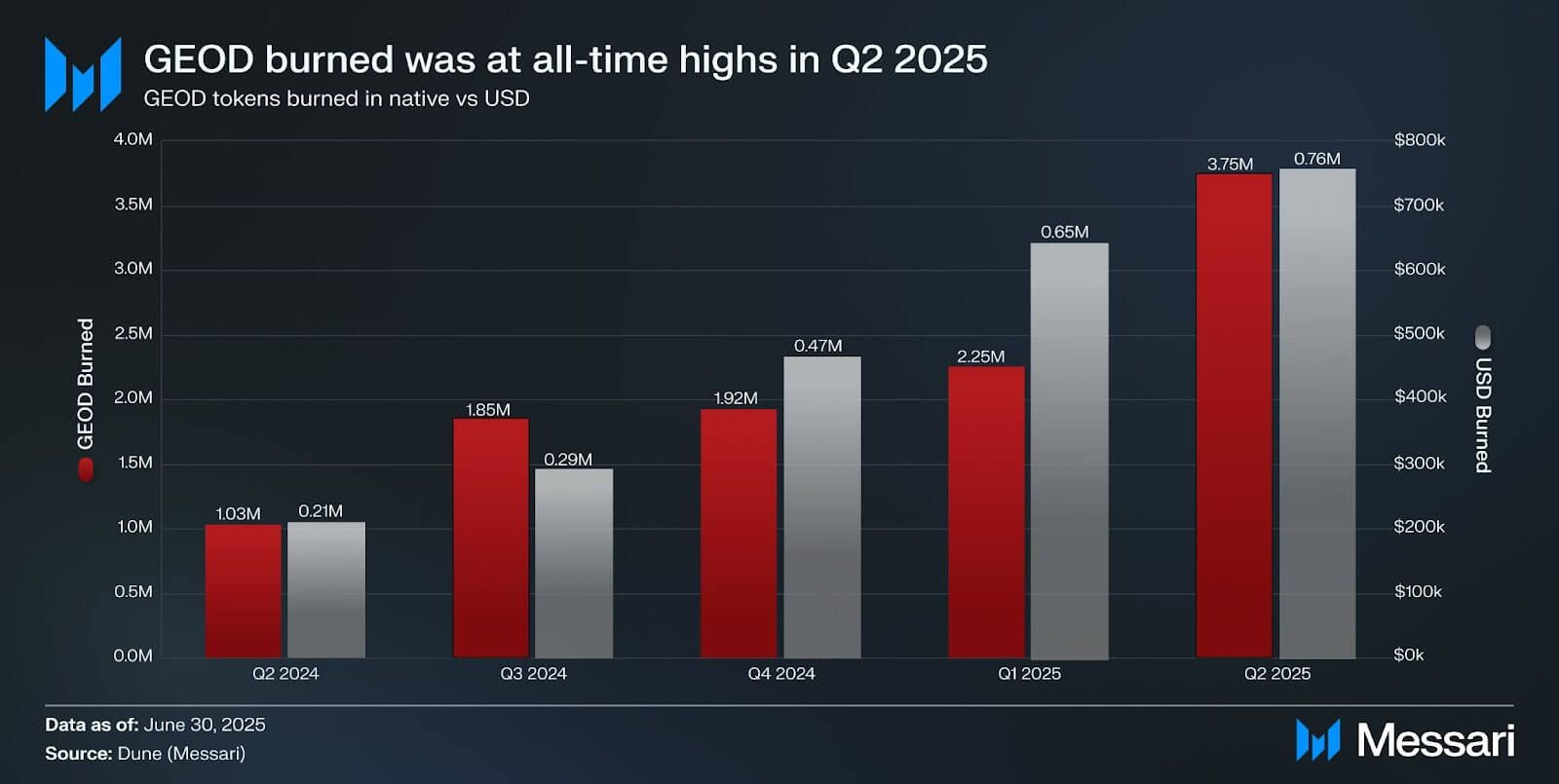
In Q2 2025, the volume of GEOD tokens burned reached 3.8 million, a 67% QoQ increase, with a total value of over $758,000, up 17% QoQ. Although growth has slowed from prior quarters, the continued rise in burn volume reflects steady revenue from RTK data sales and signals a transition toward more stable, recurring network usage.

The total supply of GEOD tokens is capped at 1 billion, with no plans for further issuance. Daily mining rewards are distributed to base station operators on a fixed schedule, while allocations for the team, investors, and ecosystem follow a multi-year vesting framework. By the end of Q2 2025, 54% of the total supply had been unlocked, up from 46% in the previous quarter. The increase was driven in part by a sharp rise in June emissions, when monthly unlocks jumped 60% from over 23 million to 30 million tokens. In total, 538 million tokens were unlocked in Q2, representing a 13% increase from 463 million in Q1.
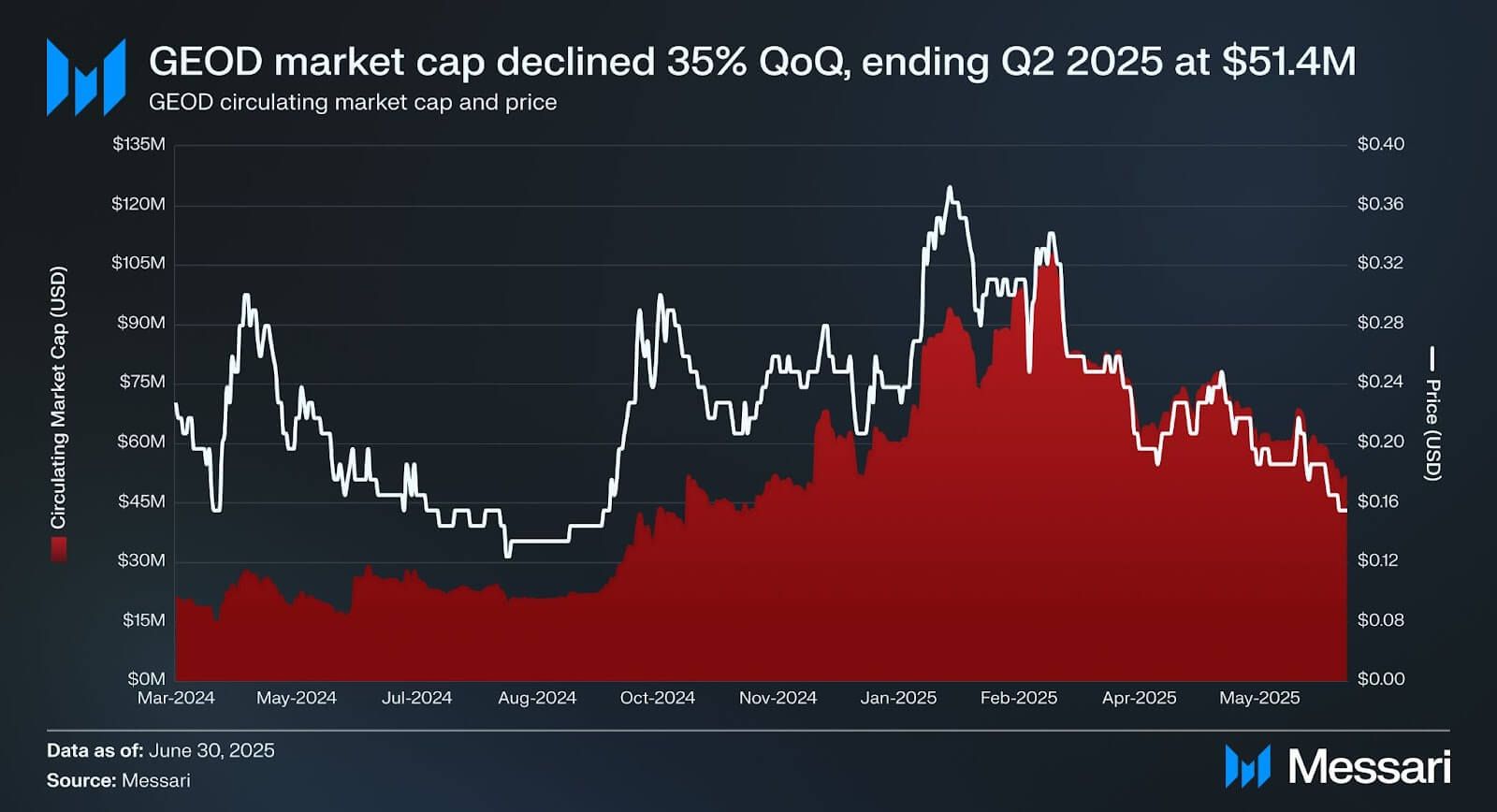
GEOD’s circulating market cap decreased by 35%, falling from $79.2 million to $51.4 million in Q2 2025. GEOD price also dropped 43% from $0.26 in Q1 2025 to $0.15. GEODNET’s sharp decline in market cap and price in Q2 2025 is primarily a reflection of broader crypto market weakness.
GEODNET is expanding its ecosystem through partnerships, integrations, and regional initiatives that drive adoption and strengthen its global network. Recent Q2 2025 developments include:
DroneDeploy Partnership: In April 2025, GEODNET partnered with DroneDeploy, a leading aerial and ground reality capture platform, to provide enterprise RTK services for drone-based reality capture. This collaboration grants DroneDeploy customers access to GEODNET’s extensive network, enhancing the precision of drone surveys in industries such as construction, mining, energy, and utilities.
Quectel Partnership: In May 2025, GEODNET collaborated with Quectel, a global provider of Internet of Things (IoT) solutions. This partnership enables Quectel to offer bundled solutions combining its RTK modules and antennas with GEODNET’s network, providing 1 centimeter positioning accuracy for applications in consumer robotics, automotive, precision agriculture, and more.
Solana Seeker Partnership: In May 2025, GEODNET partnered with Solana Mobile to launch its GEO-PULSE Quest App on the upcoming Solana Seeker smartphone. The app enables proof of location directly on the device and rewards users with GEOD tokens through quest-based activities.
Frodobots Partnership: In May 2025, GEODNET partnered with FrodoBots to support its Earth Rovers demo. FrodoBots are autonomous AI robots designed for tasks that require precise geolocation. By integrating GEODNET’s services, these robots can navigate and operate with high accuracy.
p2p.me Partnership: In June 2025, GEODNET partnered with p2p.me, a peer-to-peer crypto-to-cash exchange platform, to facilitate the off-ramping of GEOD token rewards into fiat currencies, thereby enhancing liquidity and utility for network participants.
Depin Union Membership: In July 2025, GEODNET joined the DePIN Union, a coalition launched in July 2024 by projects including Helium, Hivemapper, DIMO, and WeatherXM to promote interoperability and shared standards across decentralized infrastructure networks.
ROVR Protocol Investment: In April 2025, GEODNET co-led a $2.6 million seed round for ROVR Network, a mapping platform for collecting and distributing high-fidelity geospatial data. ROVR leverages Light Detection and Ranging (LiDAR), which uses laser pulses to measure distances and map environments in 3D, camera data, and RTK signals to generate high-resolution geospatial models. As part of the collaboration, ROVR will burn 20% of its data sales revenue in GEOD tokens, creating a direct link between platform activity and token value.
South Africa Expansion: In April 2025, GEODNET expanded its RTK network into South Africa, establishing a local presence as part of a broader push across the continent.
Korea and Japan Expansion: In July 2025, GEODNET launched an initiative to expand its RTK network across Korea and Japan by distributing free base stations with no setup cost, aiming to accelerate coverage and decentralize precision navigation across Asia.
GEOD Mining Support: In May 2025, GEODNET activated mining support on Solana, allowing miners to earn GEOD. The integration lowers transaction costs and extends the network’s accessibility across multiple ecosystems.
Halving Event: On June 30, 2025, GEODNET reduced its reward emissions by 50%, implementing a scheduled halving to curb token inflation and support long-term value. The change makes GEOD rewards more scarce, reinforcing incentives for early adopters and sustained contributors.
GEO-PULSE Hexplorer Quest: In June 2025, GEODNET launched the GEO-PULSE Hexplorer Quest, which rewards users with GEOD tokens for fixing “unfixed hexes,” which are areas in the network that lack sufficient data coverage. This initiative incentivizes users to collect high-precision location data in underserved areas, helping expand network coverage and improve geolocation accuracy.
GIP-6 Governance Proposal Passed: In April 2025, GEODNET passed GIP-6, a governance proposal introducing performance-based incentives to improve the consistency and quality of RTK stations. The mechanism is designed to enhance data reliability by rewarding stations based on their performance metrics, rather than increasing token emissions, thereby supporting sustainable network growth and higher data quality without inflating the token supply.
Congressional Testimony: In April 2025, GEODNET founder Mike Horton testified before the U.S. House Committee on Agriculture, highlighting DePIN’s role in delivering affordable, centimeter-level positioning for industries like agriculture and autonomous vehicles.
Global Conference Presence: In June 2025, GEODNET showcased its RTK-powered DePIN network at the XPONENTIAL Show, highlighting real-time precision for drones, autonomous vehicles, and smart infrastructure. Later the same month at DigiAssets London, co-founder David Chen showcased how GEOD tokens fuel their decentralized precision location network.
Policy Outreach: In June 2025, GEODNET joined other leading DePIN projects, such as Helium and Hivemapper, in Washington, D.C., for meetings with U.S. Representatives organized by the Solana Policy Institute. The discussions aimed to educate policymakers on the real-world value of DePIN infrastructure, highlighting its role in community development, job creation, and national competitiveness, to shift the narrative toward support as Congress shapes crypto regulation.
ROVR LightCone: In June 2025, a new batch of LightCones launched, advancing GEODNET’s mission to democratize precision robotics. The ROVR LightCone is GEODNET’s humanoid-shaped testbed for validating its full robotics stack in real-world conditions. Designed to operationalize the Robotics Positioning Engine, it supports data collection across navigation, perception, and control.
Global Precision Layer: In May 2025, GEODNET announced plans to expand its GNSS RTK network by integrating Low Earth Orbit (LEO) satellite tracking to improve signal reliability in dense urban and indoor environments. This upgrade is scheduled for execution later in 2025. This layer provides absolute centimeter positioning, enabling precise spatial memory for autonomous systems far beyond standard GPS capabilities.
Environmental Anchoring Layer: In 2025, GEODNET announced plans to fuse RTK data with Inertial Measurement Units (IMUs), sensors that track acceleration and rotation, and Light Detection and Ranging (LiDAR). This integration is planned to be executed in 2025 as part of GEODNET’s product roadmap. The goal is to enable precise positioning in GNSS-denied areas, such as indoors or urban canyons, by creating real-time 3D geo-referenced point clouds.
Perception and Vision Layer: In 2025, GEODNET plans to incorporate multi-camera vision systems for object detection, classification, and localization. Combined with LiDAR, which provides high-resolution depth data by using laser pulses to measure the distance and shape of surrounding objects, these systems significantly enhance situational awareness.
Compute and Cost Optimization Layer: In 2025, GEODNET is developing a custom robotics chip, RISC-V, an open-source hardware architecture. This chip is designed to power real-time sensor fusion, the process of combining data from multiple sensors (like cameras, GPS, and LiDAR) to help robots better understand and navigate their environment. The chip features built-in localization that helps robots know their exact position, and neural acceleration, which speeds up AI computations such as object detection and path planning.
Developer Tools: In 2025, GEODNET plans to roll out a suite of developer tools and integration kits to accelerate adoption across robotics, drones, and mobile applications. This includes the Mobile SDK, which enables centimeter-level positioning for consumer devices by connecting devices to GEODNET’s global satellite reference stations. First deployed through the GEO-PULSE Quest app (Android and Solana Mobile), the SDK will be accompanied by native Robot Operating System (ROS) integration and plug-and-play support for PIXHAWK and ArduPilot, the open-source autopilot stacks widely used in Unmanned Aerial Vehicles (UAVs), which are airborne robots such as drones that perform tasks like aerial surveying, inspection, and delivery.
In Q2 2025, GEODNET extended its lead as the world’s largest decentralized RTK network, surpassing 19,000 active Satellite Miners across more than 145 countries and over 4,600 cities. Although GEOD’s token price declined by 43%, from $0.26 to $0.15, and the circulating market cap fell by 35%, from $79.2 million to $51.4 million, core network activity remained strong.
Revenue from high-precision RTK geospatial services grew 19% QoQ, rising from $812,000 in Q1 to over $963,000 in Q2. This growth was driven by an expanding station network, improved data quality, and the implementation of performance-based incentives under GIP-6. In the same period, 3.8 million GEOD tokens were burned, a 67% increase from the previous quarter, with a total burn value of $758,000, a 17% increase QoQ.
GEODNET expanded through new integrations with DroneDeploy, Quectel, FrodoBots, Solana Mobile, and p2p.me, strengthening GEODNET’s presence across enterprise, mobile, and robotics sectors. Meanwhile, expansion into South Africa, Korea, and Japan, alongside membership in the DePIN Union, broadened the protocol’s global reach and ecosystem. At the protocol level, the network implemented key updates, including performance-based mining rewards (GIP-6) and a halving of token emissions, which support long-term value capture for contributors.
Looking forward, GEODNET plans to execute a series of infrastructure upgrades throughout 2025, including the integration of LEO satellite tracking to enhance GNSS reliability, the fusion of RTK with IMUs and LiDAR for precise positioning in signal-challenged environments, and the incorporation of multi-camera vision systems to improve robotic perception. It also plans to roll out a custom RISC-V-based robotics chip for real-time sensor fusion and onboard AI acceleration. Together, these initiatives position GEODNET at the forefront of precision geolocation, real-world robotics, and decentralized infrastructure for autonomous systems.
Let us know what you loved about the report, what may be missing, or share any other feedback by filling out this short form. All responses are subject to our Privacy Policy and Terms of Service.
This report was commissioned by the GEODNET Foundation. All content was produced independently by the author(s) and does not necessarily reflect the opinions of Messari, Inc. or the organization that requested the report. The commissioning organization may have input on the content of the report, but Messari maintains editorial control over the final report to retain data accuracy and objectivity. Author(s) may hold cryptocurrencies named in this report. This report is meant for informational purposes only. It is not meant to serve as investment advice. You should conduct your own research and consult an independent financial, tax, or legal advisor before making any investment decisions. Past performance of any asset is not indicative of future results. Please see our Terms of Service for more information.
No part of this report may be (a) copied, photocopied, duplicated in any form by any means or (b) redistributed without the prior written consent of Messari®.